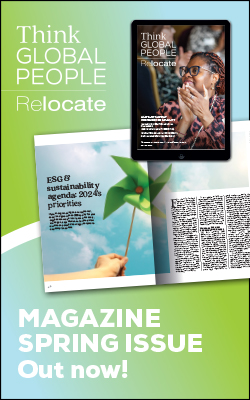Employer branding – a relocation revolution?
Almost three-quarters of CEOs are worried about securing talent, according to the Harvard Business Review. With employee experience becoming a critical competitive differentiator for companies, Dr Sue Shortland examines the intrinsic value of employer branding within global mobility and the business impact of an employee relocation experience.

– the must read for HR, global managers and relocation professionals.
Employer branding is generating a quiet revolution within the mobility landscape that cuts across a range of HR activities, from recruitment and selection to training, performance management and communications.Having internalised their relocation experience, employees go out into the world reflecting and promoting their organisation’s actions. As brand agents, employees are extremely powerful marketing and business tools and so the relocation experience is fundamental to a positive employer brand.Employer branding involves the identification of the distinct features of the employment experience within a particular organisation, strengthening and communicating these and thereby clarifying and reinforcing the attractiveness of working for that specific organisation.When successful, employer branding generates alignment with employee or internal branding, such that the workforce absorbs these unique values, and then employee behaviour actively and positively promotes the employer brand. With both employer and employee recognition that employees are fundamental to an organisation’s marketing activity.
Where marketing meets HR
The concept of employer/employee branding within the realms of HR is a fairly new concept. That said, it has rather quietly gained considerable traction, moving out from the fringes of overlap between marketing and mainstream HRM into a recognised and integral part of the role of the HR professional. Its starting point concerns the legitimate values, norms and behaviours that lie behind a corporate brand which represent the organisation in the public consciousness.Related reading from the latest issue of Relocate magazine
To differentiate one employer brand from another, benchmarking and auditing are necessary processes through which unique employment features can be identified.The employer brand should be consistently and persistently communicated to employees via images (such as logos and advertising), value statements, and day-to-day actions. These messages are brought to life by management and leadership and should be those considered appropriate and legitimate representations of what conjures up best representations of the employer’s principles.Employer branding begins with the recruitment and selection process where, in effect, it creates a continuous loop: the brand attracts talent that shares the organisational value set; and the selected employees empathise with the brand values, become brand agents, and then promote these both internally and externally. In this way, others who share these same value sets are attracted to join the organisation and the brand is strengthened and continually communicated.
The value of brand experience
Employer branding is critical to mobility success and is therefore integral to the role of mobility professionals. Working with HR and the talent management function to identify appropriate personnel for relocation (be that domestically or internationally, from internal or external talent pools) branding forms part of the mobility function’s strategic approach to talent deployment.The movement of employees to service business requirements or moving groups of employees in response to external considerations, for example in the case of Brexit, requires consideration of how relocated personnel and their families will support, reflect and actively promote the employer brand in their new location.As brand agents, relocated staff and family members can relay a positive image, face-to-face and via social media, aligned with organisational values. However, if those involved are less than enthusiastic about moving or have a poor relocation experience, their brand messages can be damaging to the organisational image. Social media can lead to widespread reputational damage in next to no time.Policy design and branding
Besides the relocation selection process, the compensation and benefits policy elements that apply to the move should reflect the value sets that underpin the employer brand. For example, a high-quality brand image which employees serving such a firm would promote, can be undermined by excessive policy component cost cutting, providing relocation service quality that is not aligned with the values that the employees are expected to promote.An organisational brand that suggests creativity and innovation can be undermined by policy components that strait-jacket the support given to mobile employees. The current trend of policy segmentation to help address cost control can reflect employee differentiation, potentially indicating different levels of value that staff can bring to a role. In a single status culture, this can be detrimental to individual employee recognition.For free downloadable factsheets on Relocation Policy Design and Review, visit our Global Mobility Toolkit
Once relocated and settled in-post, performance management conducted to be aligned with company values would be expected to reflect brand principles. Again, the mobility landscape needs careful attention – different perceptions of brand, aligned to cultural value sets may require tailoring of performance management actions to ensure local responsiveness. In this example, for employer branding to be maintained, the process of establishing and measuring performance and how this is communicated require attention. For example, an upfront straight-talking culture may be inherent within the values of an organisation – where employees are encouraged to use constructive criticism as part of promoting innovation and new ways of thinking.However, in countries where direct communications such as these are considered insensitive, relocated employees should expect to manage others’ performance in a less direct manner, or have their own performance discussed in a less confrontational way. This leads into the importance of ensuring relevant training interventions within employer and employee branding.Training is crucial if an organisation is to ensure that its employees are ‘on brand’. The employer brand would be presented to employees both directly and subtly in terms of products, services, and daily activities with the brand image and values conveyed consistently as a corporate message. With respect to mobility, a wider remit encompasses brand image and values across different geographies.A recent case in point concerns the launch of IKEA in India, where the artefacts of the organisational culture and its Swedish roots have been adapted to meet local cultural values.The IKEA brand is well-known globally but its local success in different host countries has rested upon adapting its employer brand to fit. For instance, recent press reports on the opening of India’s first IKEA store focused on the representation of the employer brand and its ‘Swedishness’ described via its restaurant foods such as its traditional meatballs. Local cultural values have resulted in these being adapted to meet ethnic and religious needs but what remains to be seen is whether the greater cultural shift away from traditional furniture to flat-pack self-assembly can take off in the traditional Indian furniture market.So what lessons does this give to mobility professionals endeavouring to support employer and employee branding when their organisations deploy people into non-traditional markets? In essence, it concerns a blending of customary images, values and activities that make up a corporate brand but with fusion into local customs and flexibility to address customer demands in new and unknown environments. Again, mobility professionals have an important role to play in promoting and gaining acceptance for appropriate training for relocated personnel which should not only deliver understanding and behavioural changes that address different cultural value sets but should also be employer-specific.
A customised approach
An important outcome of the employer branding revolution is therefore a potential departure from semi-tailored mobility products and services. Employer branding suggests, instead, the application and delivery of highly tailored, brand-specific mobility services that fully reflect, support, and continue to promote and reinforce, the brand.In turn, this highlights potential ramifications within the relocation service industry. Even greater attention will be needed to get under the skin of client cultures to ensure that advice, support and services are culturally attuned to organisational brand. In addition, fine-tuning to reflect brand image and differentiation within different local country environments will be needed, providing services that match brand at a local scale while reinforcing global image.One-size fits all or off-the-shelf product and service approaches are typically less expensive to deliver than those more closely geared to individual organisational requirements. But given the trend for cost reduction, a development towards greater mass customisation (involving flexibility, and personalisation of custom-made organisational mobility products and services but with the low unit costs usually associated with mass production), will be needed.Of course, it is generally the case that the relocation service industry and mobility professionals within organisations do tailor their activities to ensure that the personal circumstances of individuals and families on the move are met, set within corporate guidelines and policy remit. The point about employer and employee branding though, is that the design and delivery of these actions must also be highly brand-specific.In this way, the outcomes and benefits of the employer brand can be maintained and relocated individuals and their families can be sustained as positive brand carriers before, during and after their relocation experienceThis article first appeared in the autumn 2018 issue of Relocate magazine.Subscribe to Relocate Extra, our monthly newsletter, to get all the latest international assignments and global mobility news.
 Access hundreds of global services and suppliers in our Online Directory
Access hundreds of global services and suppliers in our Online Directory
©2024 Re:locate magazine, published by Profile Locations, Spray Hill, Hastings Road, Lamberhurst, Kent TN3 8JB. All rights reserved. This publication (or any part thereof) may not be reproduced in any form without the prior written permission of Profile Locations. Profile Locations accepts no liability for the accuracy of the contents or any opinions expressed herein.


































